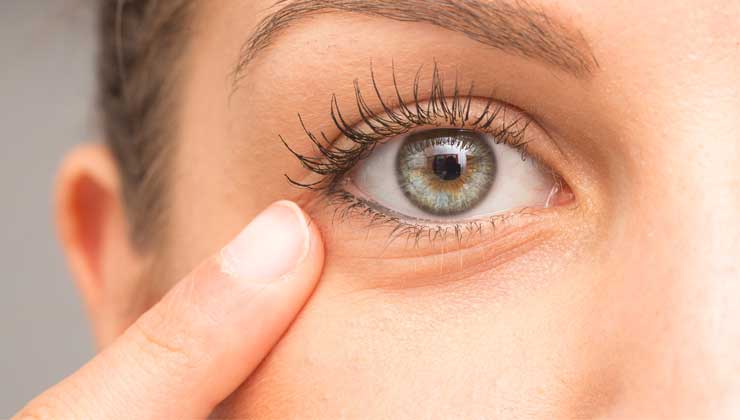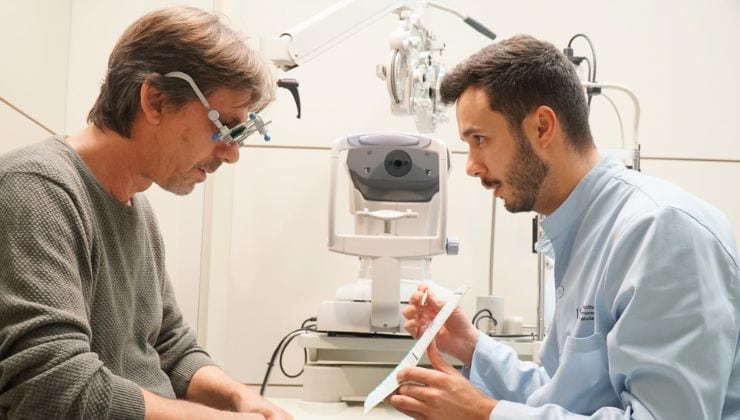What is presbyopia?
- Also known as old eyes, this refractive error is caused by loss of elasticity in the crystalline lens, the natural lens of the eye that enables it to focus on images at different distances.
- As a consequence, the capacity for accommodation decreases
- It causes difficulties in seeing objects up close with clarity
It is a process of natural degeneration of the eye that usually manifests itself from the age of 40-45.
What causes it?

The crystalline lens could be described as being like the zoom of a camera. In order to focus on nearby objects, it varies its shape and its optical power.
In young people, it is highly flexible. As people age, however, the crystalline lens becomes more rigid and its capacity for contraction (accommodation) gradually reduces, giving rise to presbyopia.
Old eyes – like cataracts (loss of transparency of the crystalline lens) – are therefore caused by the ageing of this structure, which is essential for clear vision.
How can it be prevented?

Presbyopia cannot be prevented, because it is linked to the eye’s degenerative process, which, like other parts of the body, evolves with age.
Therefore, it is a refractive error that, after a certain time, we all suffer from and, in fact, affects more than 90% of the over 45s.
It is therefore important to have regular eye checks (every year), especially after the age of 40. From this age onwards, the typical symptoms of old eyes usually appear and other age-related eye diseases begin to develop.
Symptoms
Some of the characteristic symptoms associated with this refractive error are as follows:
- Difficulty in focusing on objects at close range (less than 1 m).
- Need to move books, mobiles, etc. away to be able to see better.
- Sensation that the letters of a text are dancing on the page or are blurred.
- Headache when reading for a long time.
- Eye strain (redness, dry eye, stinging, feeling of grittiness, tearing, etc.), especially at the end of the day or in low light conditions.
As the presbyopia progresses, its impact on day-to-day life usually intensifies, although, sometimes, it is an intermittent process.
After the first symptoms, some patients seem to improve and recover their ability to focus, but then worsen later.
Associated treatments
Although presbyopia cannot be cured, there are several methods that, as with other refractive errors (hyperopia, myopia, astigmatism), help to alleviate difficulty in focusing.
Optical correction
Glasses are the most usual method, and different kinds of lenses can be used, depending on the visual needs of each patient.
Between the ages of 40 and 60, it is usual for users to need to change their prescription because of the evolution of old eyes.
Types of glasses
Monofocals: these only have the purpose of improving near vision and are typically used initially to perform precise tasks, such as reading or sewing.
Bifocals: these combine far vision (top part of the lens) and near vision (bottom part).
Occupational: in this case, the top part of the lens serves for viewing at intermediate distances and the bottom part for close distances. They are especially suitable for people who spend many hours in front of a computer.
Progressive: these progressively change the optical power to correct both near, intermediate and far vision.
As an alternative, contact lenses can also be used, but need to be individually fitted to each patient.
Surgical correction
Today, advances in refractive surgery make it possible to correct presbyopia and reduce dependence on glasses or contact lenses for many patients.
These are the main techniques used:
Laser surgery: this involves moulding the cornea to change its asphericity (curvature) and increase its depth of focus, thus compensating for the loss of accommodation of the crystalline lens.
Intracorneal lens implants: these do not have optical power (that is, they do not change the dioptres), but, like the laser, they tackle the difficulty of near vision focusing by affecting the curvature of the cornea. These lenses are positioned in the centre of the cornea and can be removed easily without altering the ocular structures, making it a reversible procedure.
Intraocular lens implants: this involves replacing the lens with a pseudophakic lens (either monofocal or multifocal), which, after a certain age, fulfils its function more effectively. The procedure used is the same as that used in cataract surgery.
Determining the type of surgery or the most appropriate treatment requires an individualised study of each patient.
Key factors in this assessment include the following: age, profession (especially those that require continued use of near vision), personal preferences, which directly influence their visual needs
Specialists who treat this pathology
FAQs
Nowadays, there are several techniques. The most popular for small refractive errors, such as myopia, hyperopia and astigmatism, is LASIK. In special cases there are other options available: phakic lenses, crystalline extraction, intracorneal lenses or intrastromal rings.
IMO Institute of Ocular Microsurgery
Josep María Lladó, 3
08035 Barcelona
Phone: (+34) 934 000 700
E-mail: international@imo.es
See map on Google Maps
By car
GPS navigator coordinates:
41º 24’ 38” N – 02º 07’ 29” E
Exit 7 of the Ronda de Dalt (mountain side). The clinic has a car park with more than 200 parking spaces.
By bus
Autobus H2: Rotonda de Bellesguard, parada 1540
Autobus 196: Josep Maria Lladó-Bellesguard, parada 3191
Autobuses H2, 123, 196: Ronda de Dalt – Bellesguard, parada 0071
How to arrive at IMO from:
IMO Madrid
C/ Valle de Pinares Llanos, 3
28035 Madrid
Phone: (+34) 910 783 783
See map in Google Maps
Public transport
Metro Lacoma (líne 7)
Autobuses:
- Lines 49 & 64, stop “Senda del Infante”
- Line N21, stop “Metro Lacoma”
Timetables
Patient care:
Monday to Friday, 8 a.m. to 9 p.m.
IMO Andorra
Av. de les Nacions Unides, 17
AD700 Escaldes-Engordany, Andorra
Phone: (+376) 688 55 44
See map in Google Maps
IMO Manresa
C/ Carrasco i Formiguera, 33 (Baixos)
08242 – Manresa
Tel: (+34) 938 749 160
See map in Google Maps
Public transport
FGC. Line R5 & R50 direction Manresa. Station/Stop: Baixador de Manresa
Timetables
Monday to Friday, 09:00 A.M – 07:00 PM









